Your resident plant lady here, to chat about Pilea Peperomioides (also known as Chinese Money plant among other fun names – more on that below)! The Pilea is well known for being easy to propagate to share with others.
This makes it a valuable plant to have in your home because onece you have one you can easily and quickly get multiple plants. Get one today and soon you’ll have many for you and your friends!
Once you find the right growing conditions (indirect bright light in well draining soil) you’ll find that this plant is an easy to grow and easy to care for plant. Below we’ll be looking it everything you need to know about the Pilea to have the best results and tons of baby plants!
This post contains affiliate links. Thanks for supporting Paisley Plants!
Table of Contents
Pilea Peperomioides Plant Basics
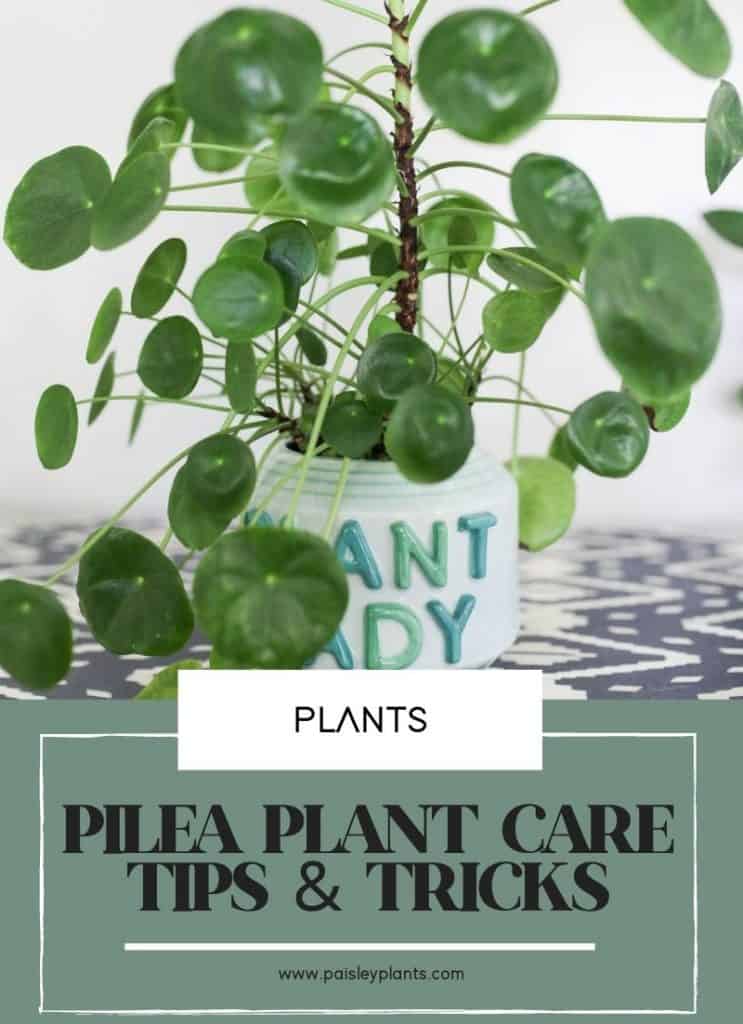
Today I’m going to share everything I know about Pilea Peperomioides plant – also known as Pilea (Pie-lee-uh), pancake plant, UFO plant, Chinese Money plant, missionary plant, friendship plant, coin plant and lefse plant.
This plant has so many different names! Anyone else love all the crazy plant names?
Pilea Peperomioides History
The Pilea is native to Southern China but very popular in Scandanavia. It’s been said that a Norwegian missionary, Agnar Espegren, discovered the Pilea plant in the Yunnan Province.
He then brought it back to Europe and propagated it there which quickly made it a popular houseplant in the U.K.. That is where the nicknames missionary plant and friendship plant came from. Pilea plants are so easy to propagate they’re easy to pass on to friends!
Pilea plants are one plant that is newer to the United States. The Norwegian missionary mentioned above didn’t discover it and thereofre sharing it with friends until the 1940s which is when the initial spread happened.
As you can imagine, it takes a few years for plants to grow enough pups to get from Europe to the US so it’s extra fun to see it popping up all around!
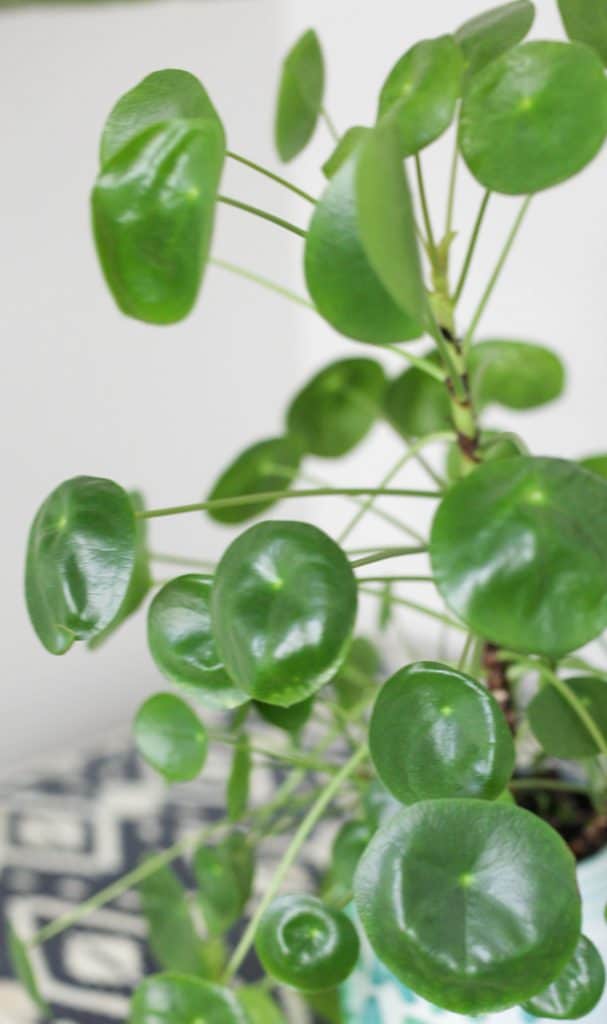
Pilea Plant Characteristics
The Pilea is known for its round, pancake like leaves in a bright green. If you look at a pilea, you’ll notice the leaves often pile on top of one another giving it the appearance of large green coins. That’s how it’s nickname of the Chinese money Plant came to be!
When it’s the healthiest with optimal growing conditions, this plant will produce small white flowers. I’ve personally never seen them on any of mine and to be honest, this plant is so beautiful without them that you won’t miss them if you never see them!
Pilea Plant Care Tips and Tricks
Like many plants, Pileas are an easy plant to grow once you find the right spot for it in your home! One you I’m on my third pilea plant and have learned so much over the years.
My first two plants came from one larger plant that I immediately split into two. I’ll get into propagating them later on but be sure to wait until your Pilea is acclimated (keeping them in their original plastic pot is just fine!) to your home before splitting them!
I think splitting them too soon and having them in the wrong spot in my home put them into shock.
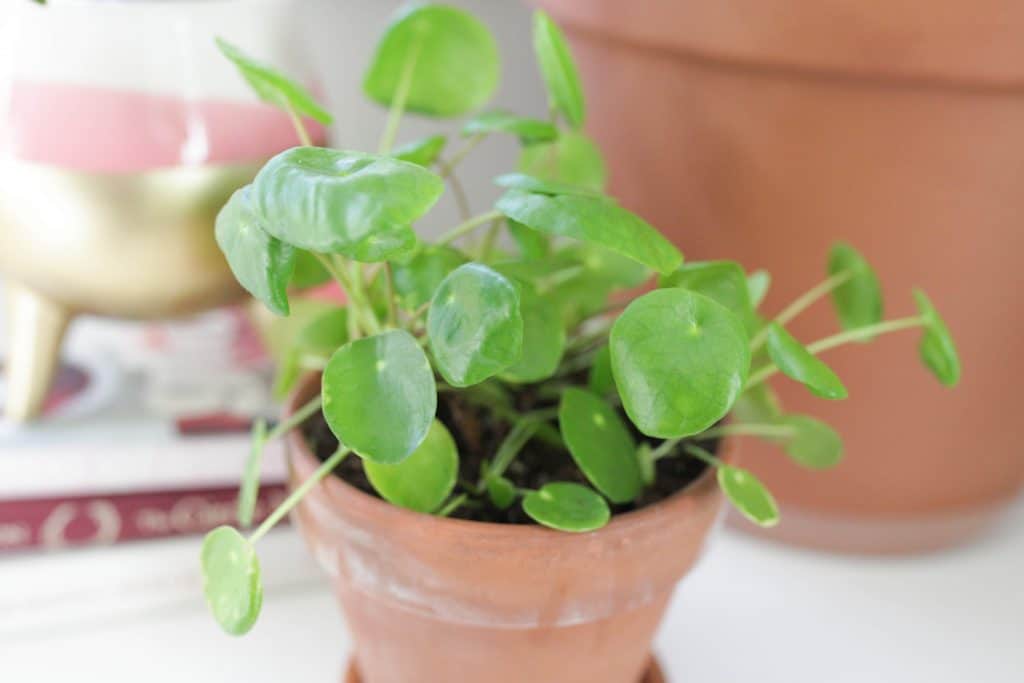
I realized the spot I had them in my office was too sunny and too drafty during the bitter cold months. Since I moved them they’re doing so much better and haven’t dropped a leaf in months!
I’m a big advocate for learning by doing and sometimes that means a little bit of failure! I’ve ended up combining my 2 plants back together in the same pot and they’re much happier!
So without further ado, Pilea plant care tips.
Water
Like most plants you should water your Pilea about 1 to 2 weeks. This depends on a few things (climate, type of pot – plants in terracotta pots typically dry out quicker than plastic pots) so keep an eye on your plant.
In most cases, Pileas need to be watered more during the summer months (or their growing season) and less in the winter (or their dormant season).
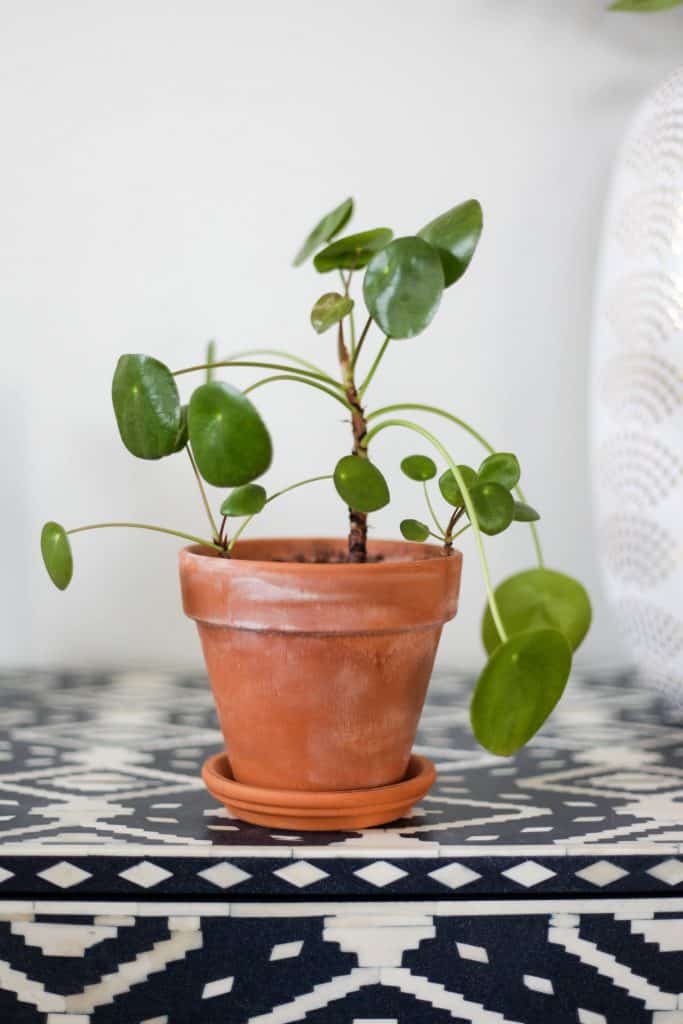
Pilea plants don’t like to be overwatered and can get root rot if they get too much water so be sure that they are dried out before watering them again. You also need to ensure you empty out the bottom dish that catches excess water after watering it. If you don’t the plant can soak up the water back into the pot causing it to be overwatered.
One trick is to simply stick your finger in the top of the soil to check it’s moisture level. If it’s dry, give it some water. If it’s still wet, leave it alone! Also be sure to put them in a pot with drainage holes to allow the water to run through.
Oftentimes your plant will tell you what it needs. If it looks droopy it likely just means it’s underwatered and needs a good drink!
Light
Chinese Money plants don’t like direct sunlight – they prefer bright indirect light. Have them near a sunny window (south or west is best) but be sure that the light they’re getting is filtered.
Bright light can scorch the leaves so make sure your pilea isn’t in a spot that gets direct sun. If they do get light, my friend in the plant world, Deborah from Gardening Collective, says to limit direct light to up to 3 hours a day.
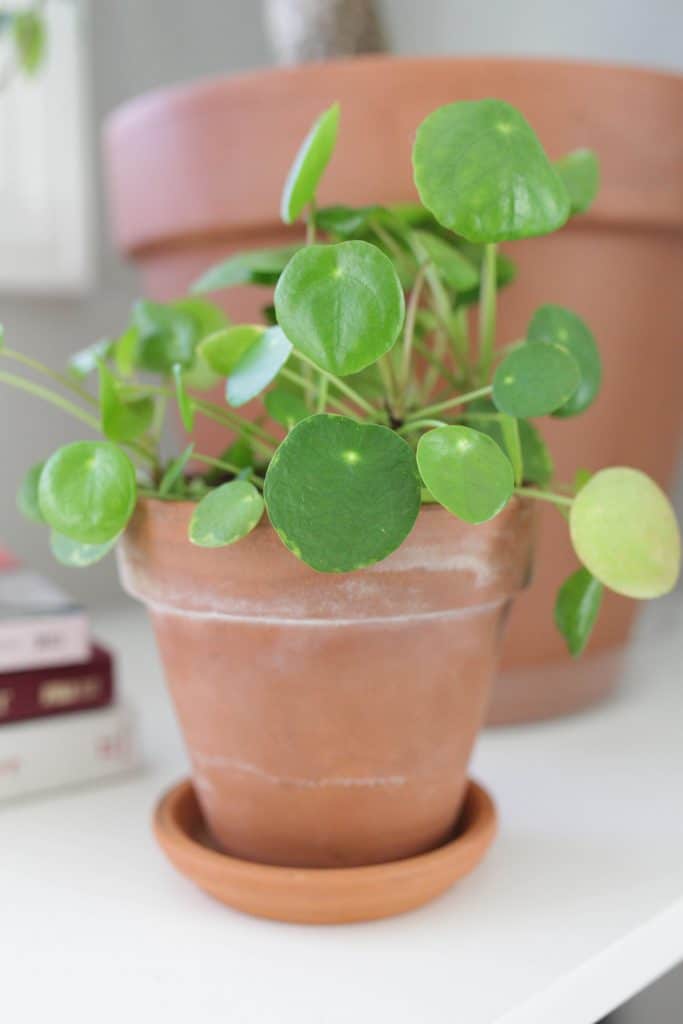
Rotate your plant if only one side gets sun! It will start to reach towards one side if you’re not rotating it. I typically rotate my Pilea every time I water it.
If you’re Pilea isn’t getting enough light it’s likely to get leggy. This means the leaves will start falling off and it will look more tree like and less bushy. If this happens move it to a spot that gets more indirect light and see if it perks up!
Soil
Pilea plants hate to be over wet so pick a well-draining and quick drying soil. Choosing something with peat moss or coir fiber is a great idea. Another way to ensure your plant dries out and doesn’t get root rot is by placing a thin layer of small stones at the bottom of your pot. This will help the water to drain properly.
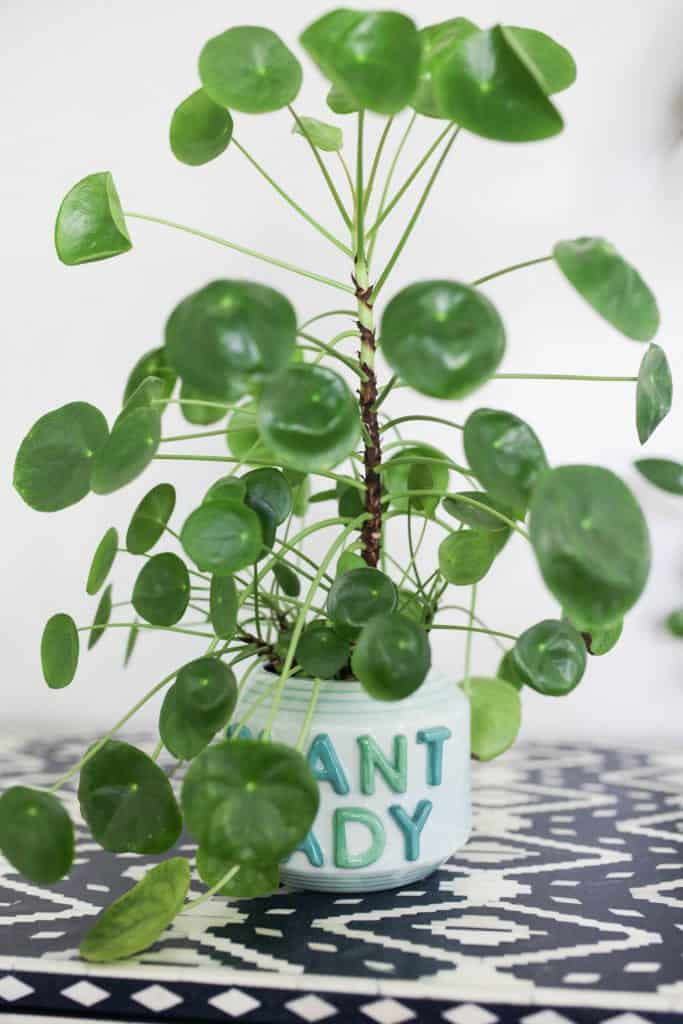
Potting
Having the right pot can make a big difference in the growth (or lack of growth) in your plant. Your pilea plant should be repotted in new soil about every 2 years. A pot with a draining hole is your best option for a healthy plant. If you don’t have a drainage hole you can always make one by drilling a hole in the bottom of your pot. Or you can put your plant in a pot with a drainage hole (like a terra cotta pot) and place that one inside a more decorative pot. That way it’ll still have the good drainage while you’ll get the beauty of a new pot!
Temperature and Humidity
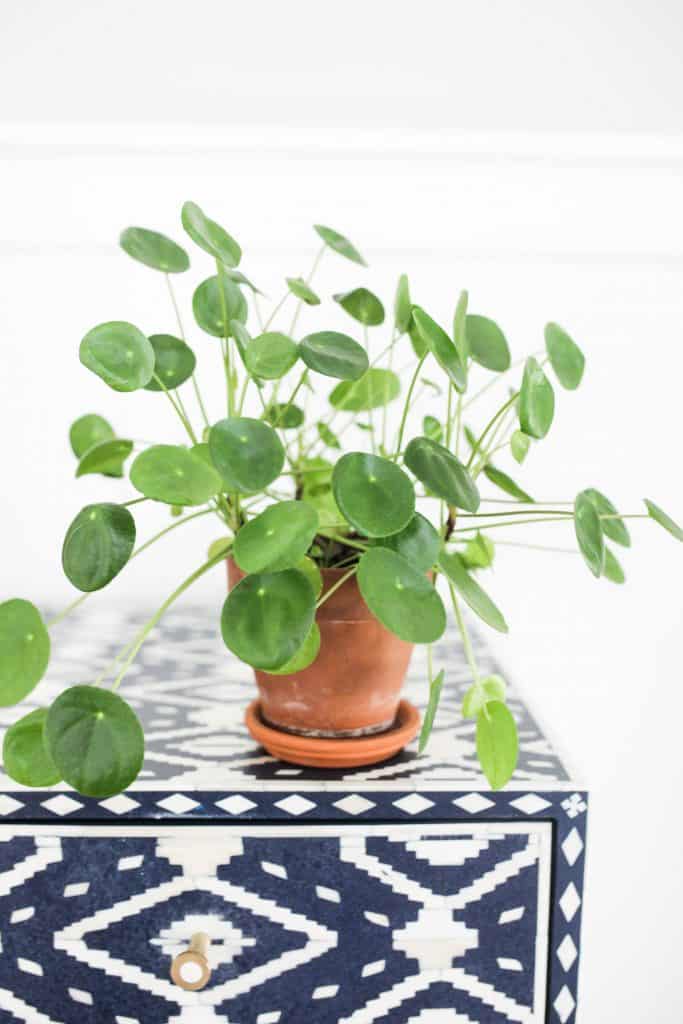
For best results, don’t let your pilea be in a spot that gets cooler than 50 degrees Fahrenheit! The like to be in comfortable temps that aren’t too drafty. They also prefer a spot that’s a bit more humid (like your bathroom) so if you have a spot there that gets a good amount of indirect bright light you should definitely try that!
I personally don’t have any of mine in more humid spots and they do just fine so don’t stress if your bathroom doesn’t have a great light situation. Always choose better light over more humidity!
Toxicity
This plant is non toxic.
How to Propagate Pilea Peperomioides Plants
Propagating a Pilea is super easy! There 2 different ways to do this – one by separating the baby plants and the other by cutting off a stem directly from the main plant.
How to Split a Baby Pilea
To propagate a Pilea you’ll be cutting off the little baby plants that shoot out next to the mother plant. Like I mentioned above, my original plant actually came with 2 large shoots so I immediately cut one off from the main and planted them both separately. Just make sure your plant is acclimated to its new home before you propagate it! My newly propagated plants did sprout additional shoots!
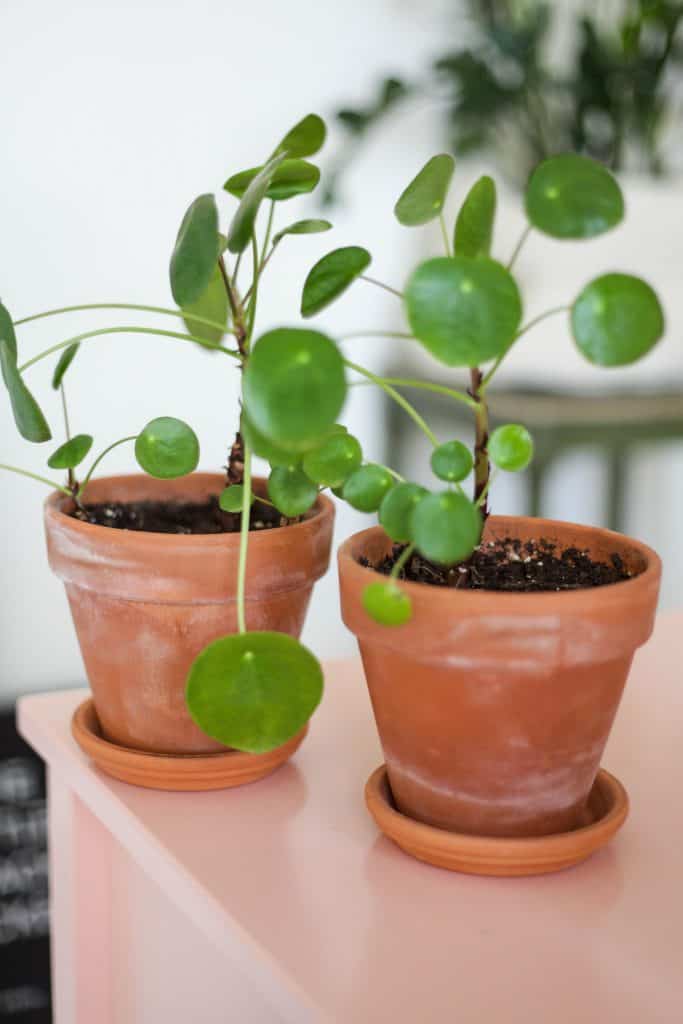
How to do this exactly is first get a sharp knife and look for the root system. Using your sharp, clean knife, cut the root system about 1 cm below the soil. The bigger the new plants the higher the chance of survival.
Then plant your new plant directly into moist soil in a new pot. It should anchor itself in just a few weeks. You’ll be able to tell when it starts growing new leaves.
How to Propagate By Cutting a Stem
You can also propagate your pilea plant but cutting it off at the stem, not at the root. Because your little plantlet won’t have roots yet if you do it this way, put it a small jar (or glass) of water, just like you would with your pothos when you propagate it.
I’ve done this when my main plant gets really leggy. I decided to chop it off and try again! It was surprisingly super easy to do and I had roots forming in just a few weeks. Just be sure to keep the water level at the point where you want to plant it. You don’t want to end up with yet another leggy plant that doesn’t look very nice!
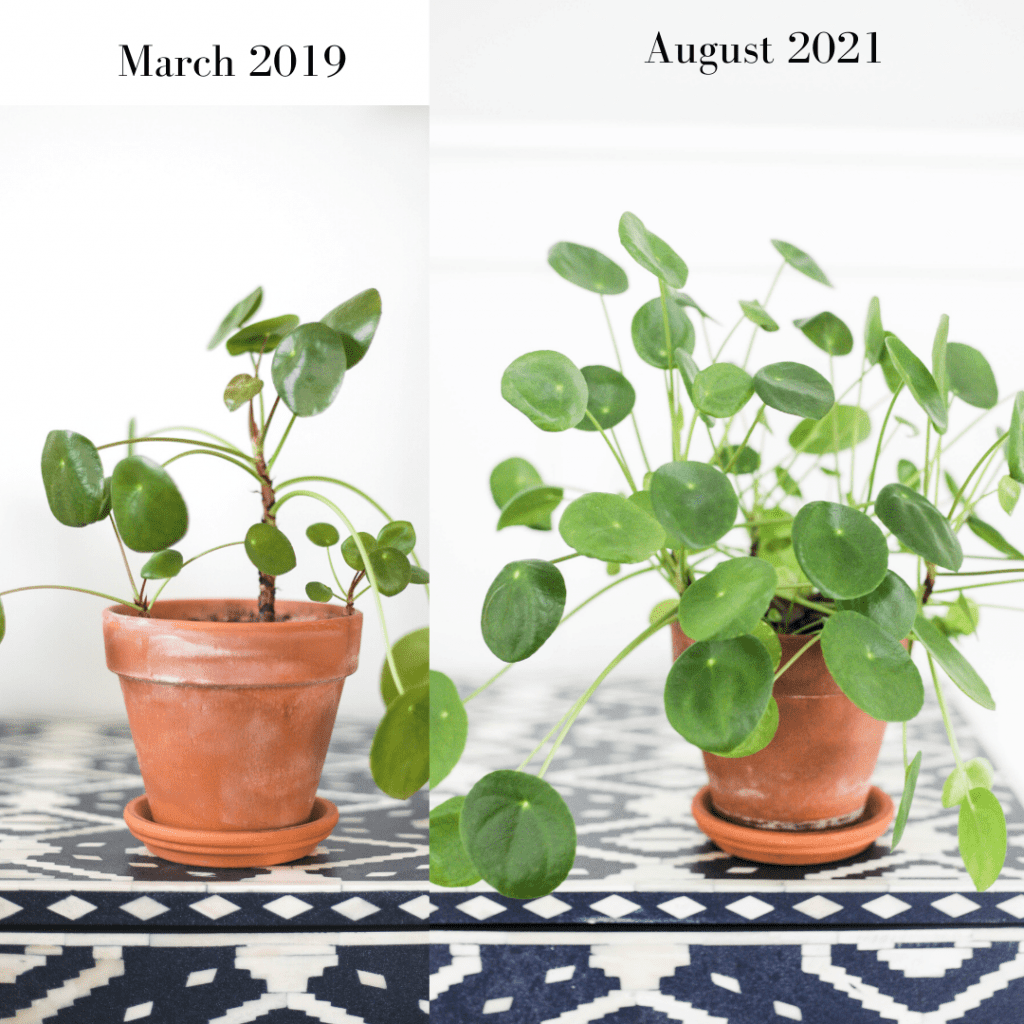
The reason they’re nicknamed the missionary plant is because they’re meant to be shared! When you see a new plantlet, cut it off and pass it on. Chinese Money plants can be hard to find so your best option is to share it with people.
(Check out the neon pothos for other easy to propagate plants!)
Where to Buy
There are many different places to buy your Pilea Plant. I’m always a fan of checking your local plant shops for plants so always start there! The staff always able to help answer questions and you won’t risk any damage in transit like you do when you purchase one online.
(Local MN friends – I love Bachmans and Tangletown Nursery.) This is becoming an increasingly popular plant so you shouldn’t have too much trouble finding a shop that carries it.
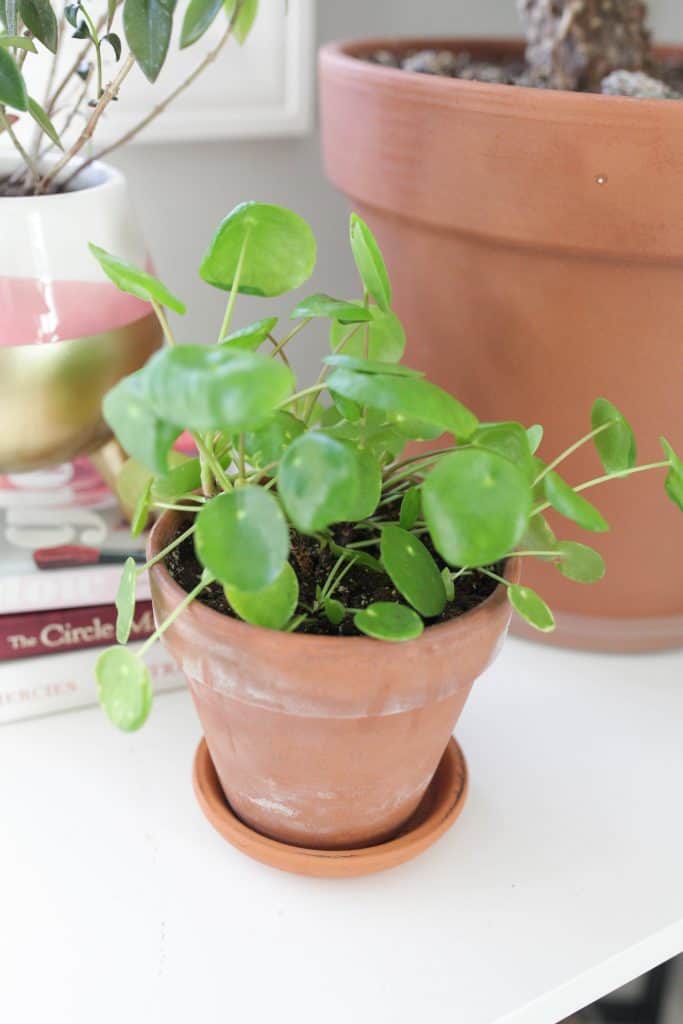
However, I have had success with online stores too!
I’ve bought (and loved) quite a few plants from the Sill and love that shop! You can also get a Pilea plant from a variety of vendors on Amazon too. Always just remember – if you buy a pilea online during winter months, always buy a heat pack to keep your plant warm. That will increase your success rate of getting a healthy plant in the mail!
Pilea FAQ
Why are my Pilea leaves curling downward?
The most common problem with your leaves curling is overwatering or insufficient drainage.
Let your plant dry completely out and the water it again – making sure to not overwater and allowing it to fully drain.
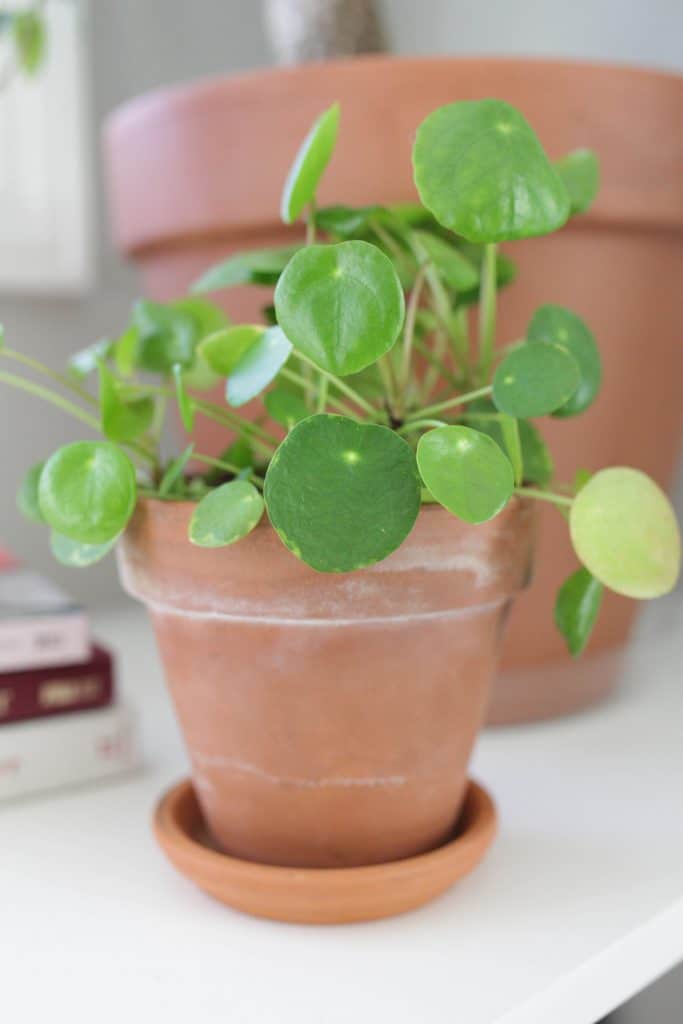
Why are the leaves drooping?
Typically the reason your Pilea Peperomioides is drooping is because it’s underwatered. Check the soil and the roots. If they seem dry, give it a thorough watering allowing the water to drain out through the drainage hole. Keep an eye on it – it should perk up in a day or two!
Do Pilea like to be misted?
Yes, they do like to be misted! Especially if you don’t have your plant in a more humid spot, misting it while mimic a humid environment.
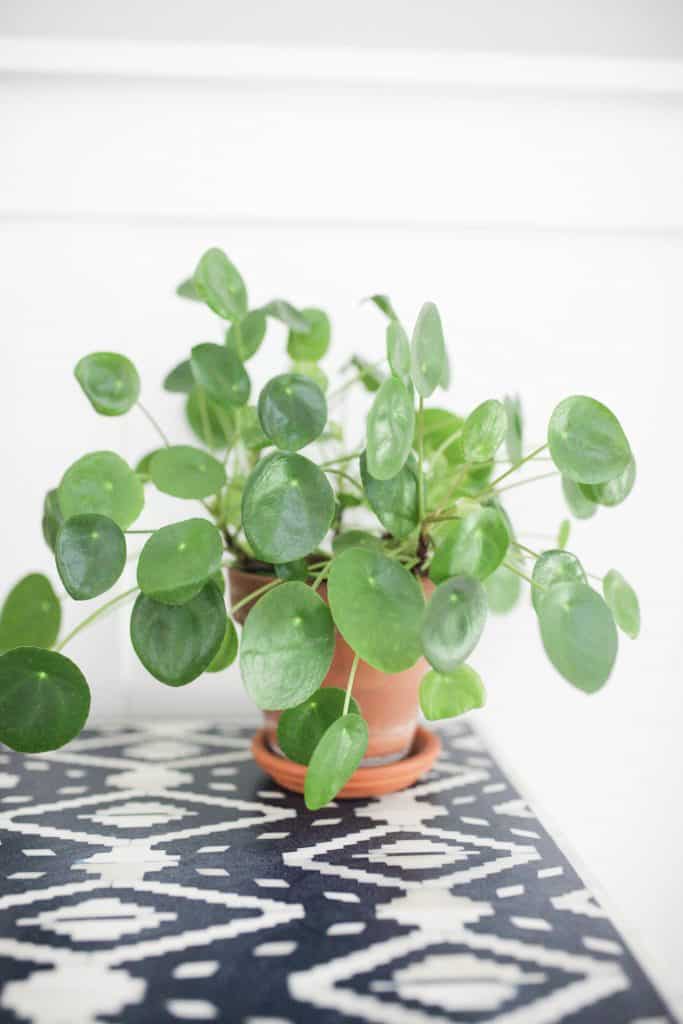
How long do Pilea plants live?
Pilea plants can live for around 10 years in the right conditions. There have been records of Pileas that live for over 20 years!
Pilea Peperomioides plants are really fun, mostly easy plants that are great additions to your home. Finding a great spot for them in bright indirect light and giving them the right amount of water in a well draining pot will be key in your success with them.
I hope this helps you know everything you need to know about Pilea Peperomioides plant care including propagating tips! Leave a note below if you have any questions!
Thanks so much for reading and sharing!
With love
Jen

